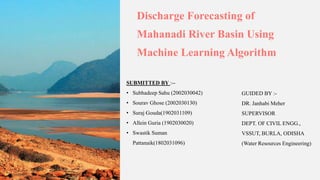The study aimed to develop a machine learning model for discharge prediction in the Mahanadi River Basin using GIS data. GIS was used to create maps of spatial features, which were integrated into a linear regression model. The model showed potential for discharge forecasting but could be improved. Future work includes analyzing longer term rainfall and discharge data, comparing additional machine learning algorithms, and enhancing predictions to support water resource management.















